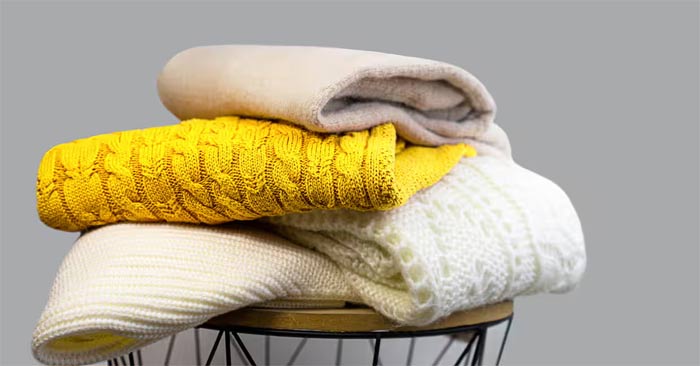Fabrics you should not wash often
From linen to lyocell, there are plenty of fabrics you can wear for another day – and some that you should barely wash. Here are the clothing materials you shouldn't wash too often.

Whether heirloom or fast fashion, all clothes need care. Not only is it respectful of the labor and resources that went into each piece, but washing them carefully & sparingly can extend their life by many years.
But not all clothes are created equal. There's a reason we throw some items in the washing machine after every wear without sorting them, and it can cause many clothes to lose their shape or color. Have you ever noticed the smell of a polyester dress after a night out? Or marveled at that sweater your dad claims he hasn't washed since 1995? Fabric matters, and you want to choose fabrics that will last.
From ancient to innovative, here are five fabrics you shouldn't wash often.
Wool
Shrinking sweaters after washing is a nightmare for many people – but when treated properly, wool is one of the easiest materials to care for. It has some antibacterial properties: its fibers are coated with a waxy layer of lanolin (the same stuff that makes sheep waterproof), which wicks moisture away from the body and resists the growth of odor-causing bacteria, meaning you can wear them over and over again without washing them. And thanks to the superfine merino wool, which is increasingly used to make T-shirts, you can even wear wool all year round.
Just steam or air dry your wool when it needs a refresh – and be sure to treat any spills quickly, as wool is more susceptible to dry stains. And when you do decide it's time to wash, use a mild or specialist detergent, and rub it gently. Wash in cool water and skip the dryer.
Denim
You may have resisted when people told you 'don't wash your jeans,' but the statement is true. With its roots in durable workwear for manual laborers, denim is designed to withstand heavy use—but not hot water. Washing it too much can lead to fading and shrinkage, as well as losing the fabric's natural tendency to hug your body over time.
It's best to spot wash to remove stains and air dry to refresh. While the clean freaks will wash it, you can do it too, but remember the rule of thumb is to clean denim after every 10 wears. And when washing jeans, turn them inside out to reduce friction damage and keep the temperature low, otherwise they will soon be unusable.

Linen
It's been around for at least 10,000 years, but linen still looks fresh every summer – and so will you, because linen is naturally breathable. It also wicks sweat away from the body, dries quickly, and has antibacterial silica, which helps prevent the stink you might associate with a hot-weather wardrobe.
Yes, linen tends to wrinkle. However, if you don't want it to fall apart quickly, it's better to steam or iron linen than to wash it too often, as wringing it out can cause wrinkles. Likewise, avoid bleach, which can damage the fabric, and skip fabric softeners, which can leave behind residue that can make linen stiffer. The best way to soften linen is to wear it repeatedly.
Hemp
Hemp makes a wonderfully comfortable fabric that, like linen, gets softer over time. It also regulates temperature thanks to its hollow fibre structure and is naturally antibacterial – all of which means you don't need to wash it too often. Plus, it's grown without pesticides, so you won't sweat.
This easy-to-clean fabric is not prone to shrinkage or deterioration and is usually machine washable. However, it is best to wash and dry on a cool setting, using a mild detergent that does not contain bleach or other harsh chemicals that could damage your soft hemp fabric.
Lyocell
Mostly sold under the brand name Tencel, lyocell is a low-impact alternative to viscose, made from wood pulp. Among its many certifications, lyocell claims to 'effectively manage moisture,' with tiny channels between the cellulose fibers helping to wick away sweat and keep you dry—which is why you'll increasingly see it used in sportswear. No one is recommending going weeks without washing your gym clothes, but for everyday wear, you'll likely find it passes the 'stink' test more often than polyester or cotton.
Spot clean the stain (but avoid rubbing too hard as this can damage the fabric) and when it's time to wash, use a gentle cycle at 30 degrees Celsius or cooler and hang to dry.
Above are the fabrics that you should not wash too often to keep them fresh. Hope the article is useful to you.
You should read it
- Create a USB connection through ... fabric
- Inventing a smart fabric that can be wirelessly charged and washed as usual
- How to Replace RV Ceiling Fabric
- Fabric that cools the body up to 8 degrees Celsius
- How to adjust the iron temperature is suitable for each type of fabric
- Learn the 4 most expensive fabrics in the world
- How to Replace an RV Awning
- How to Clean an RV Awning
May be interested
- Smart fabrics can detect and protect against harmful gases
 scientists from dartmouth university in new hampshire are developing smart fabrics that can detect the presence of toxic gases as well as protect users from their effects.
scientists from dartmouth university in new hampshire are developing smart fabrics that can detect the presence of toxic gases as well as protect users from their effects. - Tips for washing and keeping wool and felt coats new
 tired of dry cleaning? learn how to wash wool and tweed jackets at home to keep them smelling fresh and pill-free.
tired of dry cleaning? learn how to wash wool and tweed jackets at home to keep them smelling fresh and pill-free. - Levi's CEO hasn't washed jeans in 10 years, so how often should you wash jeans?
 ceo chip bergh admitted at an event a few years ago that he hasn't washed his jeans in 10 years. this caused a controversy with many conflicting opinions. so how often should jeans be washed and what is the best way to preserve them?
ceo chip bergh admitted at an event a few years ago that he hasn't washed his jeans in 10 years. this caused a controversy with many conflicting opinions. so how often should jeans be washed and what is the best way to preserve them? - Is Oshima car washer good?
 oshima car wash machine comes from japanese brand with durable copper wire motor core, smooth magnetic motor should be very trusted by customers to wash car, wash garden at home.
oshima car wash machine comes from japanese brand with durable copper wire motor core, smooth magnetic motor should be very trusted by customers to wash car, wash garden at home. - How often should you wash your car?
 have you ever thought about how a simple car wash can be an investment? how often should you wash your car and how important is it?
have you ever thought about how a simple car wash can be an investment? how often should you wash your car and how important is it? - Should a face wash machine be used for acne skin?
 although the face washer has many uses, many women still can't help worrying about using this device for acne-prone skin.
although the face washer has many uses, many women still can't help worrying about using this device for acne-prone skin. - In your opinion, should you clean or wash after going to the toilet? The answer will startle you
 the idea is simple but it turns out that the 'bowel movement' of people is very complicated, causing many people to be confused about whether to sit on the ground or squat, so clean or wash after finishing or doing both.
the idea is simple but it turns out that the 'bowel movement' of people is very complicated, causing many people to be confused about whether to sit on the ground or squat, so clean or wash after finishing or doing both. - Instructions on how to properly wash warm clothes and winter jackets
 winter clothes are often very thick and made from materials that are difficult to wash and store, so to properly wash and store warm clothes and winter clothes, remember to follow the following article!
winter clothes are often very thick and made from materials that are difficult to wash and store, so to properly wash and store warm clothes and winter clothes, remember to follow the following article! - Things You Should Wash Weekly
 washing is the basic method of cleaning clothes. however, the frequency of washing varies from item to item. here are the items that you should wash weekly, not daily.
washing is the basic method of cleaning clothes. however, the frequency of washing varies from item to item. here are the items that you should wash weekly, not daily. - How to wash your hair properly
 you don't need to buy expensive shampoos and don't have to go for regular hair care, but you can also have beautiful hair if you wash your hair properly by following these steps.
you don't need to buy expensive shampoos and don't have to go for regular hair care, but you can also have beautiful hair if you wash your hair properly by following these steps.










 The Easiest Way to Motivate Yourself to Clean
The Easiest Way to Motivate Yourself to Clean Download link for Adobe After Effects 32bit, 64bit FULL standard free
Download link for Adobe After Effects 32bit, 64bit FULL standard free Put a foil ball in the dishwasher, something surprising will happen
Put a foil ball in the dishwasher, something surprising will happen What order should I watch Attack on Titan?
What order should I watch Attack on Titan? Key combination to take screenshot on Windows and Macbook computers
Key combination to take screenshot on Windows and Macbook computers Ways to Make Money on Amazon
Ways to Make Money on Amazon